An enterprise social network (ESN) refers to businesses using internal, private social networks, software, or technology to facilitate unified collaboration and communication across the organization.
The global enterprise social networks market reached US$6.4 Billion in 2021. Forecasts expect a 13.9% CAGR, projecting the market to reach US$26.5 billion by 2032. This highlights the expansion of collaborative platforms, marking a transformative shift towards enhanced connectivity and communication strategies.
To stay ahead of shifting customer expectations and industry changes, today’s businesses require solutions that help them remain agile and continually innovate.
ESNs help to achieve this, providing modern firms with a foundation of connectedness wherein teams can drive change, create new value, and ultimately accelerate the speed of business.
This article will guide readers through the essentials of ESNs, shedding light on their purposes, offering insights into effective usage, presenting prominent ESN platform examples, and thoroughly examining both their advantages and challenges.
- What is an enterprise social network (ESN)?
- How are ESNs used?
- What are the essential components of enterprise social networks (ESNs)?
- How to effectively use an enterprise social network (ESN)
- Top enterprise social network (ESN) platform examples
- What are the benefits of enterprise social networks (ESNs)?
- What are the challenges of enterprise social networks (ESNs)?
- ESNs: A catalyst for enhanced workplace collaboration and connectivity
What is an enterprise social network (ESN)?
An enterprise social network (ESN) is the use of a private, internal social network by a business to facilitate communication and collaboration between employees pursuing shared business goals.
It encourages employees to connect, collaborate, and engage in conversation, helping to build stronger workplace relationships and knowledge-sharing capabilities across teams.
An ESN typically incorporates social software, applications, platforms, and tools for enhancing employee engagement and productivity. These digital tools facilitate instant communication, idea and document sharing, project management, task management, and collaboration capabilities.
With the pace of modern project management requiring an acute knack for communication and time management, team leaders must implement solutions that help meet these prerequisites.
The recent ascent of remote and hybrid work models adds another layer of complexity for leaders. Steering project management while facilitating the people processes that empower their operations is challenging when disparate and fragmented teams work from different locations.
How are ESNs used?
Enterprise social networks (ESNs) foster seamless collaboration, facilitate information sharing, and enhance communication within organizational structures.
Let’s take a closer look:
Internal communication
ESN solutions provide a dedicated space where users can easily communicate and connect — that’s the point of a social network. It should include essential features that enable instant messaging, oral communication, document sharing, and other interactive social elements that encourage organization-wide communication.
Project collaboration between teams
Effective project management means processes for collaboration and communication need to be lightning speed. Where enterprise collaboration software facilitates more critical aspects around data sharing, an ESN is essential for maintaining an open dialogue among teams, providing the means to communicate immediate needs, share ideas, and maintain discourse.
A space for innovation and idea-sharing
The capacity to collaborate, brainstorm, and share knowledge can not be overstated in modern business climates, where prospective success relies on how well an organization can innovate and create new value. ESNs develop environments where employees can share knowledge, ideas, and solutions for improved problem-solving. This autonomy allows employees to express independent thoughts, seek peer support, and strategize improvements for product offerings.
Community building
According to a study from the Engagement Institute, disengaged employees result in an annual cost to companies ranging from $450 billion to $550 billion. ESNs social capabilities can help address this gap by encouraging community building and employee engagement.
Employees can cultivate meaningful peer-to-peer relationships with ESNs, encouraging like-minded professionals to converge, share knowledge, seek advice, and provide feedback in a productive and welcoming space. Establishing a strong community culture can boost employee morale and productivity while generating long-term financial wins for firms.
What are the essential components of enterprise social networks (ESNs)?
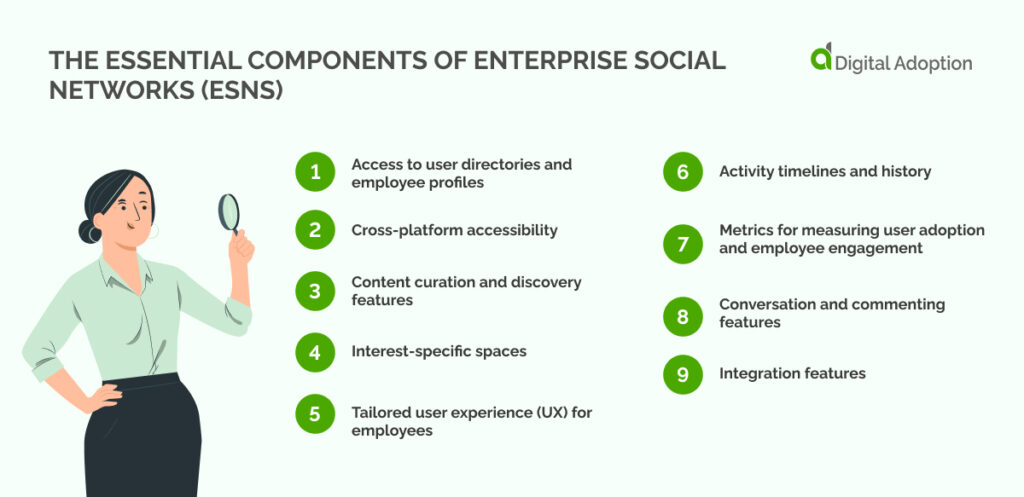
Only when users understand how to leverage ESNs to their fullest will they be able to communicate, innovate, and produce high-quality work in a way that creates authentic value.
Until then, digital adoption challenges in this area can, unfortunately, hinder communication capabilities across the organization—communication relied on to ensure swift business speed.
As such, let’s go over the essential components typically included within ESN, highlighting core capabilities and functionalities to help businesses and users get the most out of their solutions.
Access to user directories and employee profiles
Transformation efforts currently emanating across sectors means today’s organizations are often dynamic and scalable. Firms rely on swift collaboration between their many departments and large numbers of workers to effectively reach business goals.
ESNs, not unlike most public social networks, provide access to user directories, giving employees visibility into users’ information, including position, work history, accomplishments, interests, etc.
User directories contain colleague profiles, allowing employees to discover each other and contact peers across siloed teams. This helps determine who people are and better understand their roles and responsibilities in the company.
Cross-platform accessibility
The rise of remote and hybrid work means traditional workflows have been replaced with flexible and accessible solutions for productivity. The increased use of personal devices to fulfill workplace obligations necessitates cross-platform accessibility.
ESNs should be designed to function seamlessly across various operating systems and devices to ensure that users can stay connected, collaborate, and contribute from anywhere. Whether on a desktop computer, laptop, tablet, or smartphone, cross-platform accessibility empowers employees to engage with the ESN.
The Bring Your Own Device (BYOD) market is anticipated to reach USD 366.95 Billion by 2022, as reported by Global Market Insights, Inc. Effective BYOD implementation not only boosts organizational productivity but also plays a vital role in cost reduction by minimizing both operating and capital expenditures.
Content curation and discovery features
Efficient content filtering and discovery are vital features of ESN platforms. Searchable content captures essential information, underscoring the necessity for a user-friendly search function or glossary index to swiftly access relevant data.
It is imperative to set up search filters and criteria tailored to the organization’s needs. This ensures that users can pinpoint specific content, fostering a more targeted and productive collaborative environment. Additionally, content curation tools play a pivotal role, allowing users to organize and highlight valuable information.
By empowering users to curate content, ESNs encourage knowledge sharing and make it easier for team members to discover and engage with the most relevant and impactful information.
Interest-specific spaces
Interest-specific spaces revolutionize online communities, creating dedicated hubs where enthusiasts converge to share their passion.
These spaces, tailored to specific interests or hobbies, foster deep connections among like-minded individuals. Whether it’s a niche hobby, professional field, or cultural affinity, interest-specific spaces provide a platform for focused discussions, resource sharing, and collaborative exploration. Users benefit from a targeted environment beyond generic social interactions, offering a rich, immersive experience centered around shared interests.
Spaces like this also enhance community engagement and serve as invaluable sources of knowledge, inspiration, and camaraderie, redefining how people connect and collaborate online.
Tailored user experience (UX) for employees
Enterprise Social Networks (ESNs) prioritize individualized user experiences, tailoring interfaces to meet employees’ unique needs.
This customization ensures the platform aligns seamlessly with diverse roles, enhancing user satisfaction and engagement. Tailored features empower users within ESNs to curate content relevant to their responsibilities, optimizing the platform’s overall usability. This process fosters a sense of ownership and efficiency, enhancing navigation in the digital workspace.
Activity timelines and history
Activity timelines and historical tracking are integral components of ESNs, offering a comprehensive overview of organizational interactions.
These features enable users to trace the progression of discussions, project developments and shared content over time. By maintaining a detailed record of activities, ESNs facilitate transparency and accountability and serve as valuable repositories for knowledge sharing and organizational learning.
Reviewing historical data empowers users with insights to make informed decisions and build upon past experiences.
Metrics for measuring user adoption and employee engagement
Effective ESNs incorporate sophisticated metrics to gauge user adoption and employee engagement.
Analytics tools within these platforms track user activities, content interactions, and participation levels, providing valuable data to assess the platform’s efficacy. These metrics serve as key performance indicators, guiding continuous improvement efforts and ensuring that the ESN aligns with organizational goals.
Detailed insights into user behavior and engagement patterns contribute to the platform’s evolution and enhance its capacity to meet evolving organizational needs.
Conversation and commenting features
Central to ESNs are their dynamic conversation and commenting features, encouraging real-time communication and collaboration.
These platforms facilitate open dialogue through chat functionality, discussion threads, and commenting features on shared content. These features inspire active engagement and create a collaborative digital environment where employees can exchange ideas, share perspectives, and contribute insights.
The ability to comment and discuss content in real-time enhances collaboration and promotes a sense of community within the digital workspace, connecting employees across various roles and locations.
Integration features
ESNs excel in their seamless integration capabilities, allowing users to connect and share information effortlessly across diverse tools and systems. These integration features eliminate silos by enabling a cohesive digital workspace where users can access and share information without disruptions.
This interoperability enhances workflow efficiency by reducing the need for constant switching between applications. The integration features of ESNs promote a unified user experience, streamlining processes and maximizing the platform’s utility within the broader organizational context.
How to effectively use an enterprise social network (ESN)
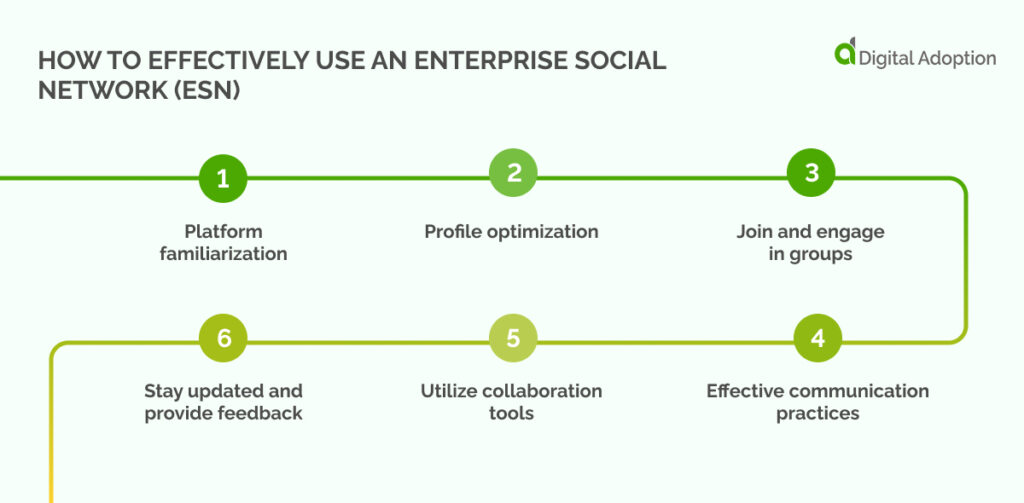
Step 1: Platform familiarization
In the first step of utilizing an enterprise social network (ESN), it’s vital to thoroughly explore its features, including accessing chat functions and locating essential tools. Simultaneously, understanding the platform’s navigation ensures seamless usage by familiarizing oneself with its layout. By effectively mastering both feature familiarization and navigation, users can optimize their experience and maximize productivity on the ESN.
Step 2: Profile optimization
To optimize your profile on the ESN, it’s imperative to establish a complete and professional identity within the digital workplace. This entails developing a comprehensive profile that includes key details such as your role, skills, and contact information. Let others easily recognize you by adding a professional profile picture, which bolsters your visibility and credibility across the platform, helping support authentic connections and interactions.
Step 3: Join and engage in groups
Active participation in various groups sustains collaboration and ensures you’re updated on essential discussions and activities within the organization. Identify and join relevant groups aligned with your projects, interests, or department to actively contribute and stay informed. Additionally, diversify your networks by engaging with diverse communities, broadening your connections, and supporting ongoing growth.
Step 4: Effective communication practices
Effective communication practices are essential for cultivating a positive and collaborative digital workspace. Familiarizing yourself with communication norms on the ESN ensures smooth interactions between teams. Practice mindful interaction by using clear, concise language and remaining aware of tone in formal and informal exchanges, which contributes to a more synchronous environment.
Step 5: Utilize collaboration tools
Efficient collaboration tools foster teamwork and ensure seamless project management within the ESN. Leveraging document sharing and collaboration features enables effective sharing of documents and resources, while real-time collaboration facilitates project collaboration, file sharing, and prompt feedback exchange among team members.
Step 6: Stay updated and provide feedback
Regularly staying updated with notifications and encouraging feedback are vital for nurturing an active and thriving ESN community and enhancing overall effectiveness. Turning on notification settings ensures timely awareness of pertinent updates while actively providing and seeking feedback creates rapport among community members.
Top enterprise social network (ESN) platform examples
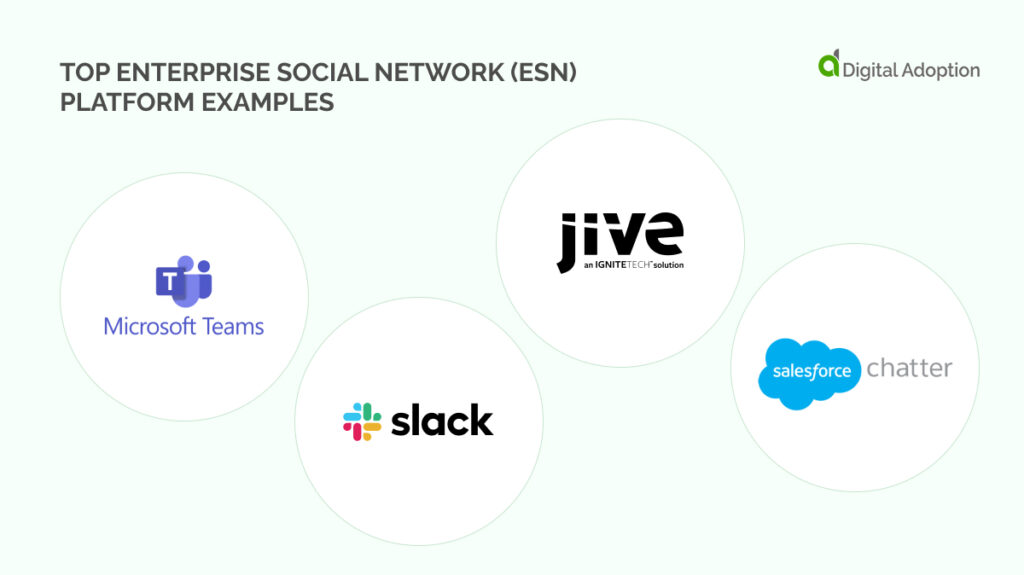
Selecting the right enterprise social network platform is paramount for fostering efficient communication, seamless collaboration, and maximizing organizational productivity.
In this section, we delve into the distinctive benefits of industry-leading platforms, aiding you in making informed decisions tailored to your business needs.
Microsoft Teams
Microsoft Teams simplifies collaboration with chat, video conferencing, and integrated document sharing. It seamlessly connects with Microsoft 365 and provides a unified workspace, enhancing productivity. Leverage channels for organized communication and ensure data security through robust features. Explore third-party app integrations for customized functionality.
Slack
Slack streamlines real-time messaging, file sharing, and integrations for effective team communication. Organize discussions through channels and enhance productivity with integrations for project management or file sharing. Slack adapts to diverse work styles, promoting a collaborative environment.
Jive
Jive offers a robust ESN platform, improving collaboration, communication, and knowledge sharing. Interactive intranet features streamline communication, creating a centralized knowledge base. Utilize document collaboration tools for efficient teamwork. Jive’s analytics provide insights into user engagement by refining communication strategies.
Chatter (Salesforce)
Crafted specifically for Salesforce, Chatter seamlessly integrates with Salesforce’s suite of business tools. Enhance communication within Salesforce workflows with social collaboration features. Receive real-time updates on leads, opportunities, and customer interactions. You can share documents and insights directly within Salesforce for cohesive communication and collaboration.
What are the benefits of enterprise social networks (ESNs)?
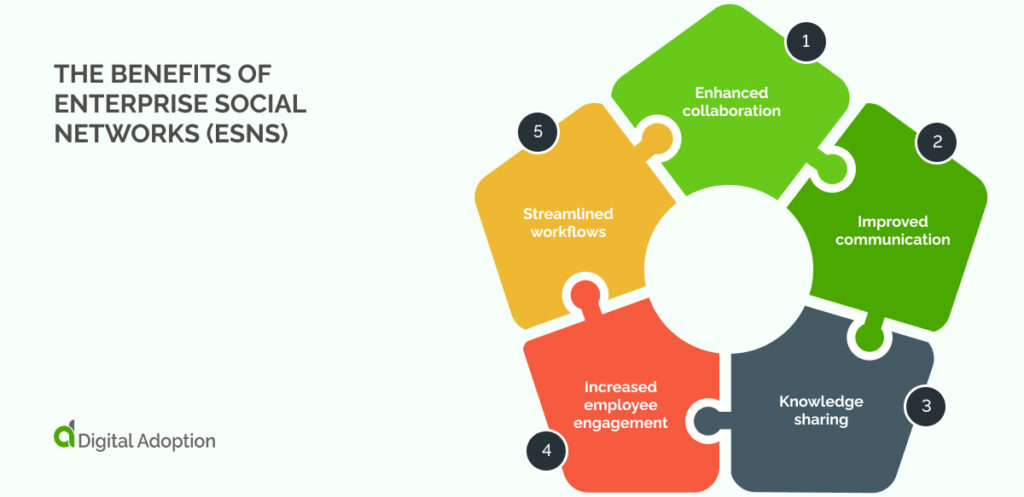
Grasping the benefits of Enterprise Social Networks (ESNs) is key to cultivating a collaborative, efficient, and vibrant workplace, leading to soaring productivity and subsequent success.
Let’s explore:
Enhanced collaboration
Enterprise Social Networks (ESNs) catalyze real-time collaboration, demolishing communication barriers among team members. With features like instant messaging, file sharing, and collaborative document editing, these platforms promote efficient teamwork and project collaboration, fostering a more connected and engaged workforce.
Improved communication
Serving as centralized hubs for communication, ESNs reduce reliance on traditional channels like email. Organizations streamline communication by offering a unified platform for discussions, announcements, and updates, ensuring that important information reaches employees promptly and enhancing overall communication efficiency.
Knowledge sharing
ESNs create dynamic environments for knowledge exchange across the organization. Through discussion threads, forums, and document sharing, employees easily exchange insights and expertise. This cultivates a culture of continuous learning, harnessing the collective intelligence of the workforce and driving innovation and creative problem-solving.
Increased employee engagement
Beyond communication, ESNs contribute to a sense of community and connectivity in the workplace. These networks foster a positive workplace culture by providing platforms for sharing experiences, celebrating achievements, and engaging in social interactions. This enhances employee satisfaction, retention, and overall team morale.
Streamlined workflows
Integrating seamlessly with various business tools, ESNs centralize access to information and resources, streamlining workflows. This simplification enables employees to collaborate on projects, access relevant documents, and stay organized more efficiently. The result is increased operational efficiency and a more productive work environment, enhancing overall business processes.
What are the challenges of enterprise social networks (ESNs)?
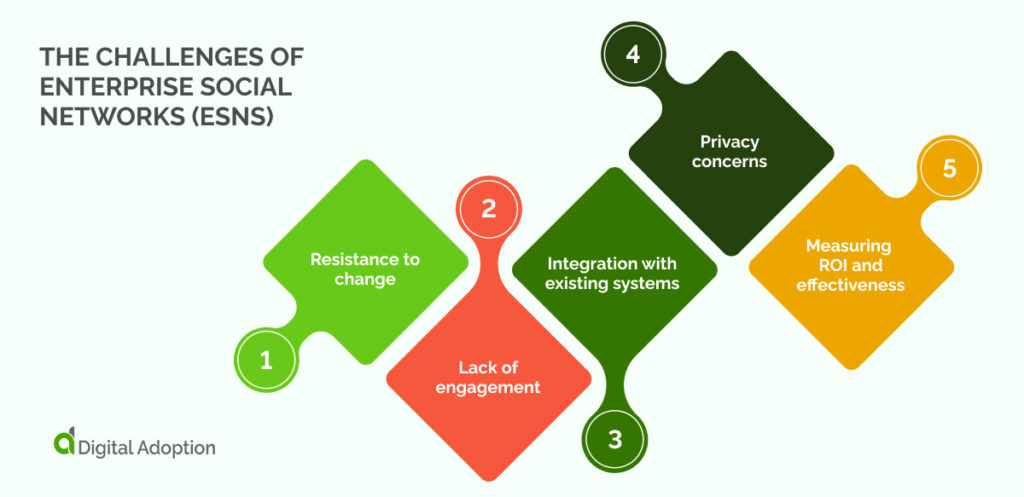
Understanding and addressing these challenges is crucial as it allows organizations to proactively navigate potential obstacles, optimize the implementation of Enterprise Social Networks (ESNs), and foster a workplace environment that embraces collaboration, innovation, and sustained productivity.
Let’s explore:
Resistance to change
Overcoming resistance to change is a prevalent challenge when introducing Enterprise Social Networks (ESNs). Employees may be hesitant because of unfamiliarity with the platform, concerns about potential disruptions, or fears about how the new system might impact their work routines. Addressing these apprehensions through effective communication and comprehensive training programs is crucial.
Lack of engagement
Maintaining consistent and meaningful engagement in ESNs is a perpetual challenge. Even after successful implementation, employees may not actively participate if they fail to see the platform’s relevance to their daily tasks or perceive it as an additional, non-essential tool. Encouraging participation through showcasing real-world benefits and fostering a collaborative culture is essential.
Integration with existing systems
Seamless integration of ESNs with existing organizational tools and systems poses a technical challenge. Compatibility issues may arise, affecting the efficient flow of information between different platforms. Addressing these integration challenges requires careful planning, often involving collaboration between IT specialists and platform providers to ensure a smooth technological transition.
Privacy concerns
Employee apprehensions regarding protecting their personal and professional information on ESNs can hinder widespread adoption. Organizations must establish robust privacy policies, transparent data practices, and clear guidelines to alleviate concerns. Building trust is essential to foster an environment where employees feel secure sharing information on the platform.
Measuring ROI and effectiveness
It can be intricate to determine the return on investment (ROI) for ESNs and assess their overall effectiveness in enhancing communication and collaboration. Quantifying the impact on productivity, innovation, and employee satisfaction requires comprehensive metrics and analytical tools. Organizations must establish clear benchmarks and regularly evaluate the performance of ESNs to justify their continued use and identify areas for improvement.
ESNs: A catalyst for enhanced workplace collaboration and connectivity
ESNs are helping to facilitate modern workplace collaboration, fundamentally reshaping team dynamics and boosting how the organization connects with each other.
Investing in ESNs is pivotal for businesses seeking to prepare for the challenges and opportunities of digital transformation. These platforms seamlessly integrate into the collaborative work environment, offering a unified digital space where employees can communicate, share insights, and collectively drive success.
Promoting open communication and knowledge-sharing, ESNs contribute to breaking down silos, thus enhancing collaboration across teams and departments.
In the relentless pursuit of competitiveness amidst the digital revolution, ESNs emerge as indispensable catalysts for fostering organizational adaptability and innovation.
They hold the power to guide businesses through the intricacies of contemporary work, enabling real-time collaboration, nurturing a sense of community, and propelling agile responses to ongoing industry shifts.




![18 Examples of AI in Finance [2025]](https://www.digital-adoption.com/wp-content/uploads/2025/06/18-Examples-of-AI-in-Finance-2025-300x146.jpg)
![14 Examples of AI in Manufacturing [2025]](https://www.digital-adoption.com/wp-content/uploads/2025/06/14-Examples-of-AI-in-Manufacturing-2025-300x146.jpg)
![29 Examples of AI in Education [2025]](https://www.digital-adoption.com/wp-content/uploads/2025/06/29-Examples-of-AI-in-Education-2025-300x146.jpg)
![15 Examples of AI in Retail [2025]](https://www.digital-adoption.com/wp-content/uploads/2025/06/15-Examples-of-AI-in-Retail-2025-300x146.jpg)
![13 Examples of AI in Healthcare [2025]](https://www.digital-adoption.com/wp-content/uploads/2025/06/AI-in-healthcare-examples-300x146.jpg)


![18 Examples of AI in Finance [2025]](https://www.digital-adoption.com/wp-content/uploads/2025/06/18-Examples-of-AI-in-Finance-2025.jpg)
![14 Examples of AI in Manufacturing [2025]](https://www.digital-adoption.com/wp-content/uploads/2025/06/14-Examples-of-AI-in-Manufacturing-2025.jpg)
![29 Examples of AI in Education [2025]](https://www.digital-adoption.com/wp-content/uploads/2025/06/29-Examples-of-AI-in-Education-2025.jpg)